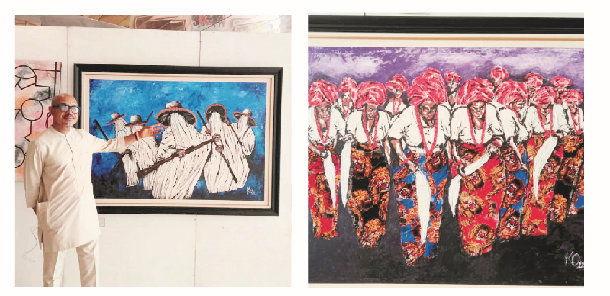
The ArtWalk Exhibition Event and the ArtWalk Icon of Creative Arts Award; what are they about?
The Icon of Creative Awards goes with ArtWalk ExhibitionEvent. Through the ArtWalk Exhibition Event we showcase Nigerian artworks. Most of my works, and those exhibited today showcase the diverse cultures of Nigeria, through which we create connections between Nigerian cultures. The works are rendered in fabrics and acrylics applied on canvas. They invoke emotions, characters and disciplines of various Nigerian communities and people.
The ArtWalk Icon of Creative Arts Award is part of ArtWalk and Events. It is an affiliate of APCAD, through which we recognise personalities who sponsor arts. We also have an organ where we mentor artists through visiting universities and communities to groom young artists, to create awareness in the creative industry.
This solo exhibition of my works is just an opportunity to promote art and the creative industry under ArtWalk and Events. The ArtWalk Icon of Creative Arts Awards held on March 23, 2024, while the exhibition ran from March 23 to 28 at the Transcorp Hilton Hotel, Abuja.
Who were the award recipients of the ArtWalk Icon of Creative Arts Awards, and why were they awarded?
We awarded the Icon of Creative Arts to the Senate President, Godswill Akpabio because he is a promoter of arts, but also because we are trying to sponsor a bill in the National Assembly to promote the creative industry. He has been promoting the arts since he was a governor and supporting artists.
National Assembly member, Hon Osita Izunaso, also received the award; same as Professor Obiora Nwankwo, who is the chairman of the United Nigerian Airlines Company Limited, and the owner of The Dome entertainment space – which has served as a hub for popular arts and entertainment for the past twenty years.
Other awardees include entrepreneur and founder, Nigeria Entrepreneurship Summit & Honours (NESH), Emeka Ugwu-Oju; the ‘Philanthropic Billionaire’ Terry Waya, and the traditional Prime Minister of Anara Ancient Kingdom and President/CEO of City Games Homes.
Some of these men also support the younger artists whom we mentor.
As observed, a major theme of the exhibition is culture. Why do you think there is still a need to represent culture on canvas today?
We do so because culture transcends time. When we represent culture on canvas, we are trying to represent harmony and peace. After the general elections of 2023, there has been a lot of dichotomy in Nigerian society that stems from politics. We are trying to unite the whole country via our diverse cultures.
At the exhibition, people appreciate the world from the southeast, Edo State, from the south-south and the north. And when you understand the cultures of these diverse people, then you begin to appreciate and love them. This is what we are trying to do with this series, which is the fourth of the exhibition we are hosting here at Transcorp Hilton. We do this to promote the industry.
As an artist who has been capturing cultures on canvas, what would you say is the one thing that Nigerian cultures have in common?
Most cultures of Nigeria differ, which defines the people. The commonality among them is that quick realisation that people delight in promoting their culture. Politics often brings about a dichotomy which makes it difficult for people to appreciate one another. What we are doing with this exhibition is to ensure when Nigerians from other ethnicities see the cultures of other ethnic groups depicted on canvas, they are able to appreciate them. Don’t forget that what you don’t understand, you can’t interpret, but what you understand you can appreciate.
There are references to politics in some of the paintings that I saw on display, like the Campaign/Rally and Supporters Club.
There is nothing wrong with those words, just that they have been bastardised by modern politics and politicians. The particular work you are talking about is called the Assembly. What I try to portray with the work is to convey the colours and diversity of the people. If you look at that work, it’s called Campaign; we just depicted our style of work. It is just to depict an Assembly of people in an environment, which happens to be politics. It can also be interpreted as a group of people who meet to promote their culture. The work is subject to any interpretation, but the work in particular is a picture of an Assembly of people who could have assembled for any purpose.
Talk about the Supporters’ Club painting?
It is a football supporting club. The colours therein represent the Chelsea colours, the Arsenal colours, the Liverpool colours, etc. It’s a semi-abstract representation of football supporters’ clubs leaving the field together after a game.
What is the place of your art in the context of Nigerian and African art space?
I have exhibited all over the world, in the UK and Europe, and my works are collected all over the world. I lead an organisation of over 5,000 members, all of whom I mentor. I have supported a large number of them to exhibit their works abroad, and we have a platform where we put up their artworks to sell for them. To see this done, and to see these artists’ artwork is being appreciated gives me joy.
From an individual level, I have reached every zenith that anyone can reach in art. It is not about me anymore; it is about younger artists.
I have been practising art for the past 27 years, and my works are collected by all kinds and levels of people.










